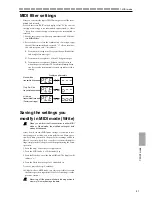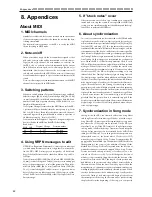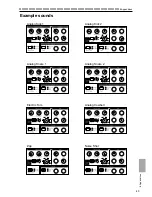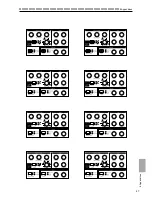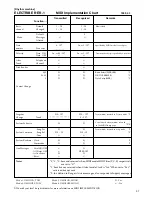
40
7.MIDI mode
○ ○ ○ ○ ○ ○ ○ ○ ○ ○ ○ ○ ○ ○ ○ ○ ○ ○ ○ ○ ○ ○ ○ ○ ○ ○ ○ ○ ○ ○ ○ ○ ○ ○ ○ ○ ○ ○ ○ ○ ○ ○ ○
7. MIDI mode
In MIDI mode you can make MIDI-related settings, and dump
exclusive data. Press the MIDI mode key to enterMIDI mode.
To exit MIDI mode, press the mode key for the previous mode.
If you turn off the power without Writing, the settings
you made in MIDI mode will be lost. If you wish to keep
the modified settings, you must execute the Write op-
eration (refer to p.41 "Saving the settings you modify in
MIDI mode").
MIDI channel settings
(MIDI ch)
MIDI ch
1...16
This sets the MIDI channel. The same MIDI channel is used for
both transmission and reception.With the factory settings this
will be “
10
”
1. Use the cursor keys to make the parameter select LEDs indi-
cate
MIDI ch
.
2. Rotate the dial to select the channel.
Setting the MIDI note
number for each part
(Note No.)
Note No.
C-1...G9
Here you can specify the MIDI note number for each part.
If you specify the same note number for two or more parts, the
sounds of those parts will be played simultaneously when that
note is received from an external MIDI device.
1. Use the cursor keys to make the parameter select LEDs indi-
cate
Note No
.
2. Press the part key whose note number you wish to change
(the key will light).
3. Rotate the dial to select the note number.
The factory settings are as follows.
Part
Note number Note name
Percussion Synth 1
C2
36
Percussion Synth 2
D2
38
Percussion Synth 3
E2
40
Percussion Synth 4
F2
41
Audio In 1
G2
43
Audio In 2
A2
45
Hi-hat (Close)
F#2
42
Hi-hat (Open)
A#2
46
Crash
C#3
49
Handclap
D#2
39
The correspondence between note names and note
numbers will differ by manufacturer. Please refer to the
owner’s manual for the device you have connected.
Transmit/receive dump
data(MIDI Data Dump)
Dump
Ptn, SnG, ALL
Transmission
Here's how system exclusive data (pattern data, song data, or
Global mode settings) can be transmitted from the
ER-1
to an
external MIDI data filer or computer connected to the
MIDI
OUT
connector.
1. Connect the
MIDI OUT
connector of the
ER-1
to the MIDI
IN connector of an external MIDI device that is able to re-
ceive MIDI data dumps (another
ER-1
, or a computer that is
running a MIDI data filer program or editing program, etc.).
2. Set the MIDI channel of the external MIDI device and the
ER-
1
to match. However when transmitting to a data filer, it is
not normally necessary to match the MIDI channel.
3. Use the cursor keys to make the parameter select LEDs indi-
cate
Dump
.
4. Rotate the dial to select the data that you wish to transmit.
Ptn
: All pattern data
SnG
: All song data
ALL
: All data (pattern data, song data, Global data)
5. Press the Play/Pause key to transmit the data dump.
Reception
Here's how
ER-1
system exclusive data can be received from an
external MIDI data filer or computer connected to the
MIDI IN
connector.
1. Connect the
MIDI IN
connector of the
ER-1
to the MIDI OUT
connector of the external MIDI device that will transmit the
MIDI data dump (another
ER-1
, or a computer that is run-
ning a MIDI data filer program or editing program, etc.).
2. Set the MIDI channel of the external MIDI device and the
ER-
1
to match. However when transmitting from a data filer, it is
not normally necessary to match the MIDI channel.
3. Use the cursor keys to make the parameter select LEDs indi-
cate
Dump
.
4. Transmit the data dump from the external MIDI device.
Details on data dumps are provided in the MIDI implementa-
tion chart of the ER-1.
Consult your local Korg distributor for more information on
MIDI implementation
Do not touch the keys of the ER-1 while a data dump is
in progress.
When the parameter select LEDs indicate Dump, sys-
tem exclusive data can be transmitted or received even
if the MIDI Filter parameter "E" is set to "-."
If the MIDI Filter parameter "E" is set to "O," system
exclusive data can be transmitted or received in any
mode.
Содержание Electribe R ER-1
Страница 47: ...47 8 Appendices 8 Appendices ...
















